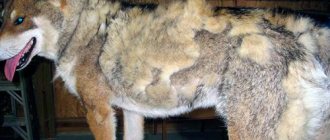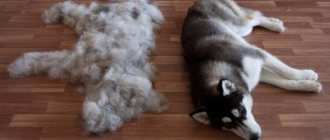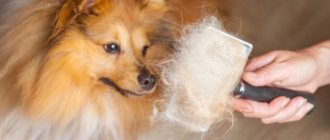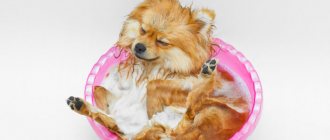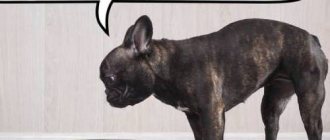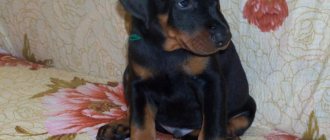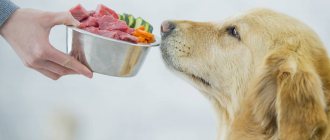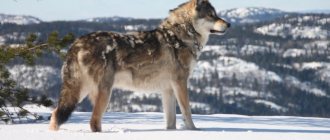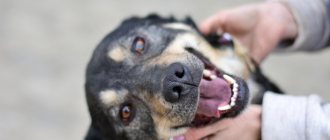Owners of various breeds face periods of shedding in dogs. And this is inevitable. This process is completely natural. Shedding is most noticeable in dogs that have naturally thick and long coats.
Naturally, owners don’t like the fact that during the seasonal shedding period, whole clumps of fur are spread throughout the house and stick to clothes. But it is not possible to abandon this process. What is molting?
Thanks to this physiological process, the body reacts to changes in the temperature of the environment. But if the process of hair loss is observed not only in spring and autumn, then this may indicate the presence of a serious disease.
It is important to understand which shedding does not require additional supervision from a veterinarian, and in which cases it is necessary to take your pet to a specialist.
Why is the shedding mechanism needed in dogs?
A dog's fur is a secondary organ, but still an organ. The coat protects our pets from bad weather, sunlight, injuries during fights and disorders of the central nervous system.
Dogs' skin is very sensitive, therefore, pets without hair are more likely to suffer from:
- Heat and sunstroke.
- Hypothermia.
- Various skin diseases.
- Inflammatory processes on the skin caused by mild trauma and secondary infection.
Understanding how important wool is, it becomes obvious why the shedding mechanism in dogs is needed. This is a renewal of the coat, and with it the body’s defenses.
Hairless and short-haired dog breeds are genetically adapted to reduce risks. Left unprotected, their skin became thicker and less sensitive. However, short-haired dogs need to be dressed in the cold season, protected from overheating in the summer, and bathed more often.
What is considered normal
In a global sense, dogs can be divided into:
- Shedding - with and without undercoat.
- Non-shedding - most wire-haired terriers, poodles, Yorkshire terriers, Bedlington terriers.
The norm for shedding dogs is:
- Complete shedding of the undercoat in spring.
- Full molt 2 times a year.
- No unpleasant odor if the dog's fur is dry.
The molting period may vary depending on the climate. Molting occurs in spring and autumn. Spring molting is more intense, especially in females. During the autumn shedding, most dogs grow an undercoat that looks like a dense felt layer.
Non-shedding dogs are bred artificially and therefore require human help to renew their coat. All dogs, except wire-haired ones, need regular haircuts. During the haircut, split ends are removed - this improves the metabolic processes of the hair.
From a practical point of view, the coat is cut shorter than prescribed by the breed standard, but not too short so that the dog does not freeze or overheat.
Pay attention! Veterinarians and professional groomers do not recommend cutting dogs that do not shed. Contrary to popular belief, in hot weather, wool protects against overheating, rather than causing it.
Most Wirehaired Terriers also do not shed and require trimming. Dead wool forms the so-called shell (crust). To keep the dog looking good and healthy, dead hair is plucked.
What breeds don't shed
Unfortunately, there are no breeds that do not shed at all. Some dogs shed significantly less hair than others, but they still shed some hair. These breeds include the following:
- Irish Water Spaniel.
- Soft coated wheaten terrier.
- Yorkshire Terrier.
- Poodle.
- Boston Terrier.
- Welsh Terrier.
Almost all terriers and lap dogs shed little, but if you want a pet whose hair does not fall out at all, then special hairless dogs have been bred that have no hair at all, so they cannot shed even during the season.
Dog shedding depending on the time of year
Depending on the time of year, a dog’s shedding may shift slightly or be delayed if the pet lives in climatic conditions unnatural for the breed. For example, huskies and malamutes are genetically adapted to live in harsh, cold climates. If a dog lives in a warm climate, its shedding cycle may be disrupted.
As mentioned above, normally, molting should occur in spring and autumn. However, if the spring turns out to be cold, the molt may shift to early summer. When shedding is delayed, the dog’s body is “provoked” by brushing and bathing. A similar shift can occur during a very warm autumn, in which case the undercoat may appear only at the beginning of winter and may not be too dense.
Dog sheds in summer
Increased shedding in summer is a very common phenomenon. Bitches are more prone to increased shedding during hot periods, while males have an increased risk of overheating at this time.
Intense hair loss in the heat is a natural reaction of the body. The fur on the belly, armpits and tail may become very thin. However, the dog should not lose hair on its body (back, sides), head or chest.
The dog sheds in winter
If a dog sheds in winter, this is a sign of a violation of natural metabolic processes. Most often, winter shedding occurs in dogs living in an apartment. The reason for this unusual phenomenon is the elevated temperature and dry air in the home.
If a dog begins to shed in winter, care must be taken to ensure that their resting place is as far as possible from heating radiators. Artificial air humidification also helps to stop unwanted watering. Shedding in winter is not only undesirable, but also dangerous, as it often provokes skin diseases and hypothermia during walks.
The dog sheds all year round
Shedding all year round is a clear sign of health problems. Once you notice warning signs, you need to identify the problem. In a global sense, hair loss can be called:
- Shedding is hair loss against the background of the growth of young hair.
- Baldness.
Important! The dog's fur may not fall out, but break off at the root - this is a guaranteed symptom of a skin or other disease.
Causes
There are many factors and reasons due to which a pet's coat may suffer. Many of them appear together with other symptoms and signal distress or serious illness:
- Nutrition is one of the most common problems leading to poor appearance in animals. Each breed has its own needs that must be met. If the dog lacks some specific vitamins, or the menu is not balanced correctly, there is little protein or vitamins, then the appearance of such an animal will soon leave much to be desired. An excess of some substances will also have a bad effect. Select food based on the breed, age and individual needs of the animal. You cannot feed a puppy food for an adult dog, and give a shepherd dog a portion of a Yorkie.
- Immunity problems . The most common in this case are vitamin deficiency and hypervitaminosis, each of them is dangerous in its own way. Lack of vitamins during pregnancy and lactation or due to poor nutrition quickly affects your appearance. Hypervitaminosis is no better, the body cannot cope with the influx of nutrients, they begin to poison it. Most often this happens due to poor care, if the dog eats both dry food and natural food, and also takes vitamin supplements that were not prescribed by a veterinarian.
- Fungal skin diseases most often manifest as alopecia areata, but not always. Sometimes the skin affected by microorganisms becomes dry throughout the body, peeling and a constant feeling of itching appear. In this case, you can solve the problem simply by bathing your pet with a special antifungal shampoo.
- Allergies, both food and not . Anything can cause an allergic skin reaction in a dog, from a certain food product, a drug taken, or the fabric from which a suit for street walks is sewn. The solution in this case is quite simple: switch to hypoallergenic food, take antihistamines and extremely careful combing, which should not irritate the skin. You can accurately determine that you have an allergy by additional symptoms: redness of the skin and peeling.
- Hormonal imbalances , which seriously affect the functioning of the entire body, can lead not only to severe shedding, but also to complete baldness. Acquired problems can be solved with the help of drugs and therapy, but if the disease is congenital, then little will help, even if the diagnosis is made to a very young puppy.
- Diseases of the pancreas and liver . In this case, only a veterinarian can make an accurate diagnosis, and he will prescribe the appropriate treatment. Despite the fact that the liver is a self-healing organ, it still becomes ill due to poisoning and constant infectious diseases, and one of the symptoms of this is alopecia.
- Stress is one of the most common causes of shedding at the wrong time, for example in winter. Dogs have their own character and temperament, so they are quite easy to unbalance. Moving or simply traveling to an unfamiliar place, too loud noises and other circumstances that frighten dogs can easily lead to nervous hair loss, so you need to try to protect your pet from unwanted shocks. Otherwise, molting will last a very long time.
READ ALSO: Vitamins for dog fur
Factors that provoke molting
Factors that provoke molting depend on:
- Care.
- Feeding.
- Degrees of activity.
- Health status.
- Environment.
Grooming refers to the frequency of bathing and brushing the dog. The condition of the skin and coat directly depends on the type and balance of nutrition. Diet is the first aspect of grooming that needs to be reviewed if your dog's coat appears unhealthy or is shedding heavily.
The degree of activity is a factor on which the metabolic rate directly depends. If the dog only eats and sleeps, hair loss is the least of the problems that may arise.
Temporary or chronic deterioration in health is another common cause of intense and untimely shedding. Note that the condition of the skin and coat is considered an indicator of health. A dog that is not feeling well will have dull, unkempt, dry and brittle fur.
Dog shedding after spaying or neutering
Intensified, unscheduled shedding after castration or sterilization is an absolutely expected phenomenon, especially for purebred animals. Castration has been a standard procedure for many years, but it is performed under general anesthesia, which means:
- Sedation.
- Drug use across generations.
- Enhanced analgesic therapy during surgery.
- Some doctors use epinephrine to reduce bleeding.
- Analgesic and sedative therapy after surgery.
- Injection of long-acting antibiotics or a course of antibiotics after surgery.
Note! Hair loss is a sign of stress that the dog experiences every time he visits the veterinary clinic.
Shedding that begins suddenly will most likely stop spontaneously within 5–7 days.
Why Wool May Look Bad
As a rule, a dog sheds constantly for various reasons. But this shedding is preceded by a change in the condition of the coat. So, initially the dog’s fur may become dull and hard, and only then the hairs will begin to fall out.
This can happen for a number of reasons:
- Poor, unbalanced or irregular diet.
- Diseases of the gastrointestinal tract.
- Kidney diseases.
- Decreased immunity.
- The appearance of parasites in the animal's body.
Hair loss is a consequence of the appearance of such factors. When the disease has already been cured, many owners observe that the dog still sheds heavily. What to do in this case? Nothing, wait a certain time. Due to the stress experienced, shedding may continue for several months after treatment.
Additional warning symptoms
If your dog starts shedding intensively and not according to schedule, this can be explained by dozens of natural reasons. If shedding began due to health problems, the pet will experience additional alarming symptoms.
The dog has dandruff
Contrary to popular belief, dandruff is not the same as flaking skin. Dandruff or something similar to it can be a symptom of:
- Fungal skin infection.
- Infections with skin parasites.
- Metabolic disorders.
- Improper functioning of the skin glands.
Unfortunately, the origin of dandruff is almost impossible to determine at home. Metabolic disorders mean several dozen abnormalities, the most common of which are:
- Food allergies.
- Flea dermatitis.
- Non-food allergies.
- Unbalanced diet.
If your dog has dandruff and its amount is constantly increasing, it is recommended to immediately contact a veterinary clinic. The doctor will take skin scrapings and examine them under a microscope. Promptness is important because the dandruff you see may be the result of parasites.
What to do and how to stop/slow down shedding
What to do and how to stop/slow down shedding:
- Maintain an acceptable temperature in the apartment. Practice shows that a dog may begin to shed prematurely if a constant temperature in the home is maintained above 26 degrees.
- Monitor air humidity. For the health of dogs and people, optimal indicators depend on the season of the year. In summer 30–60%, in winter 30–45%.
- Feed your dog correctly. Practice shows that timely adjustment of the diet can weaken or stop shedding in a matter of days. If hair problems occur regularly in a dog, many veterinarians recommend switching pets to specialized industrial food.
- Walk your dog actively, especially in winter. The more time an animal spends in an apartment, the higher the risk of untimely molting.
- Don't bathe your dog too often. To keep the coat in good condition, simply brush it with a soft brush.
Note! To maintain the normal functioning of metabolic processes, long-haired, pregnant, and young dogs are recommended to be given vitamin and mineral supplements on an ongoing basis.
Special grooming procedures
Properly selected vitamin and mineral complexes and nutritional supplements can reduce the duration and intensity of the seasonal process. If they do not have a noticeable effect, you should consult a veterinarian. He will tell you what to do when your dog sheds heavily. You can also use grooming services.
Express molt
Professionally performed combing is called express shedding. It is carried out by a master in a hairdressing salon for animals, that is, in a grooming salon.
Express shedding includes brushing with a furminator brush, bathing with shampoo and conditioner, and drying with a special hairdryer. The procedure makes it possible to remove up to 90% of dead hair, and the effect lasts up to 3 months.
Trimming
Removing dead hair by plucking is called trimming. This is a health and hygiene procedure carried out in the salon. Trimming is recommended for wire-haired breeds (listed above), which find it difficult to shed dead particles on their own. A salon procedure is performed on average once a quarter, which allows you to maintain a neat appearance for your pet.
Rules for feeding a dog with heavy shedding
The rules for feeding a dog with heavy shedding involves introducing into the diet foods that contain the necessary substances:
- Yolk, liver, beef tripe, soft boiled cartilage.
- Any natural, fermented milk products.
- Fruits, vegetables, herbs.
- Boiled seafood (source of trace elements, Omega 3 and Omega 6).
If problems with fur arise due to an allergic reaction or sensitivity of the digestive system, it is wiser to switch the dog to commercial preventive food.
Vitamins and supplements in a dog's diet
To maintain a healthy coat, you can use vitamins and supplements in your dog's diet. Natural additives:
- Yeast.
- Gelatin.
- Meat and bone meal.
- Fish fat.
Industrial vitamin complexes:
- Excel Brewers 8 in 1.
- VEDA PHYTOMINS for wool.
- Laveta Super Beaphar.
- Farmavit NEO “Wool Perfection”.
Many owners speak positively about vitamin supplements (with a simple composition) for people: Undevit, Revit, etc. Regardless of the choice of supplements, remember that an excess of vitamins is no less dangerous than their deficiency . Strictly follow the instructions of the drugs and alternate natural supplements.
